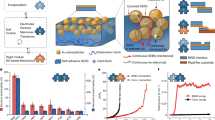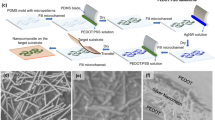Abstract
Microdevices can be integrated on conformable substrates to create high-performance and multifunctional human–machine interfaces. However, existing integration schemes often use unpatterned, thick and rigid adhesive layers that can increase the flexural rigidity and compromise mechanical compliance. Here we report the site-selective and anisotropically conductive integration of microdevices on conformable substrates. An adhesive precursor is selectively deposited on high-density arrays of microdevices using a velocity-controlled dip-transfer coating method. This technique suppresses capillary action and unwanted coating between devices, thereby minimizing the extent of bonding areas that degrade the inherent compliance of polymeric substrates. Ferromagnetic particles in the adhesives are magnetically self-assembled into well-defined anisotropic chains, resulting in a low contact resistance without electrical interference between fine-pitch terminals. We use the approach to additively integrate multiscale, die-level microdevices on various flexible and stretchable substrates. We show that it can be used to assemble microscale light-emitting diodes and a microcontroller die on a flexible circuit to create a skin-attachable device capable of detecting and displaying temperature.
This is a preview of subscription content, access via your institution
Access options
Access Nature and 54 other Nature Portfolio journals
Get Nature+, our best-value online-access subscription
$29.99 / 30 days
cancel any time
Subscribe to this journal
Receive 12 digital issues and online access to articles
$119.00 per year
only $9.92 per issue
Buy this article
- Purchase on Springer Link
- Instant access to full article PDF
Prices may be subject to local taxes which are calculated during checkout






Similar content being viewed by others
Data availability
The data that support the findings of this study are available from the corresponding authors upon reasonable request.
References
Kathe, C. et al. Wireless closed-loop optogenetics across the entire dorsoventral spinal cord in mice. Nat. Biotechnol. 40, 198–208 (2022).
Lee, J. H. et al. Wearable surface-lighting micro-light-emitting diode patch for melanogenesis inhibition. Adv. Healthc. Mater. 12, 2201796 (2023).
Li, J. et al. Ultrathin, soft, radiative cooling interfaces for advanced thermal management in skin electronics. Sci. Adv. 9, eadg1837 (2023).
Yao, K. et al. Encoding of tactile information in hand via skin-integrated wireless haptic interface. Nat. Mach. Intell. 4, 893–903 (2022).
Liu, Y. et al. Electronic skin as wireless human-machine interfaces for robotic VR. Sci. Adv. 8, eabl6700 (2022).
Jung, Y. H. et al. A wireless haptic interface for programmable patterns of touch across large areas of the skin. Nat. Electron. 5, 374–385 (2022).
Toyozawa, K., Fujita, K., Minamide, S. & Maeda, T. Development of copper wire bonding application technology. IEEE Trans. Compon. Packag. Manuf. Technol. 13, 667–672 (1990).
Chan, Y. C. & Luk, D. Y. Effects of bonding parameters on the reliability performance of anisotropic conductive adhesive interconnects for flip-chip-on-flex packages assembly II. Different bonding pressure. Microelectron. Reliab. 42, 1195–1204 (2002).
Park, S.-I. et al. Printed assemblies of inorganic light-emitting diodes for deformable and semitransparent displays. Science 325, 977–981 (2009).
Kim, R.-H. et al. Waterproof AlInGaP optoelectronics on stretchable substrates with applications in biomedicine and robotics. Nat. Mater. 9, 929–937 (2010).
Park, S. I. et al. Light emission characteristics and mechanics of foldable inorganic light-emitting diodes. Adv. Mater. 22, 3062–3066 (2010).
Lee, S. H. et al. Optogenetic control of body movements via flexible vertical light-emitting diodes on brain surface. Nano Energy 44, 447–455 (2018).
Kim, R.-H. et al. Stretchable, transparent graphene interconnects for arrays of microscale inorganic light emitting diodes on rubber substrates. Nano Lett. 11, 3881–3886 (2011).
Choi, M. et al. Stretchable active matrix inorganic light-emitting diode display enabled by overlay-aligned roll-transfer printing. Adv. Funct. Mater. 27, 1606005 (2017).
Wang, C. et al. Programmable and scalable transfer printing with high reliability and efficiency for flexible inorganic electronics. Sci. Adv. 6, eabb2393 (2020).
Park, J.-B. et al. Stable and efficient transfer-printing including repair using a GaN-based microscale light-emitting diode array for deformable displays. Sci. Rep. 9, 11551 (2019).
Lee, J. S. et al. Nanoscale-dewetting-based direct interconnection of microelectronics for a deterministic assembly of transfer printing. Adv. Mater. 32, 1908422 (2020).
Hwang, H. et al. Stretchable anisotropic conductive film (S-ACF) for electrical interfacing in high-resolution stretchable circuits. Sci. Adv. 7, eabh0171 (2021).
Lee, H. E. et al. Monolithic flexible vertical GaN light-emitting diodes for a transparent wireless brain optical stimulator. Adv. Mater. 30, 1800649 (2018).
Guo, C. et al. Large-scale programmable assembly of functional micro-components for advanced electronics via light-regulated adhesion and polymer growth. npj Flex. Electron. 6, 44 (2022).
Michoud, F. D. R. et al. Epineural optogenetic activation of nociceptors initiates and amplifies inflammation. Nat. Biotechnol. 39, 179–185 (2021).
Gupta, S., Navaraj, W. T., Lorenzelli, L. & Dahiya, R. Ultra-thin chips for high-performance flexible electronics. npj Flex. Electron. 2, 8 (2018).
Yokota, T. et al. Ultraflexible organic photonic skin. Sci. Adv. 2, e1501856 (2016).
Lu, T., Wissman, J., Ruthika & Majidi, C. Soft anisotropic conductors as electric vias for Ga-based liquid metal circuits. ACS Appl. Mater. Interfaces 7, 26923–26929 (2015).
Lau, J. H. Recent advances and new trends in flip chip technology. J. Electron. Packag. 138, 030802 (2016).
Shang, B. et al. Numerical and experimental study on the transferred volume in phosphor dip-transfer coating process of light-emitting diodes packaging. J. Electron. Packag. 138, 021003 (2016).
Wolf, F. G., Dos Santos, L. O. E. & Philippi, P. C. Capillary rise between parallel plates under dynamic conditions. J. Colloid Interface Sci. 344, 171–179 (2010).
Baek, S. et al. Effects of tube radius and surface tension on capillary rise dynamics of water/butanol mixtures. Appl. Sci. 11, 3533 (2021).
Qian, B. & Breuer, K. S. The motion, stability and breakup of a stretching liquid bridge with a receding contact line. J. Fluid Mech. 666, 554–572 (2011).
Delannoy, J., Lafon, S., Koga, Y., Reyssat, E. & Quere, D. The dual role of viscosity in capillary rise. Soft Matter 15, 2757–2761 (2019).
Kinloch, A. J. & Kinloch, A. J. Adhesion and Adhesives: Science and Technology (Springer Science & Business Media, 1987).
Ghatak, J., Huang, J.-H. & Liu, C.-P. Derivation of the surface free energy of ZnO and GaN using in situ electron beam hole drilling. Nanoscale 8, 634–640 (2016).
Ziff, R. M. Spanning probability in 2D percolation. Phys. Rev. Lett. 69, 2670–2673 (1992).
Tang, Y., Wang, R., Zhang, Y., Li, S. & Du, P. Anisotropy of percolation threshold of BaTiO3-Ni0.5Zn0.5Fe2O4 composite films. Sci. Rep. 9, 7855 (2019).
Jin, S., Tiefel, T. & Wolfe, R. Directionally-conductive, optically-transparent composites by magnetic alignment. IEEE Trans. Magn. 28, 2211–2213 (1992).
Moon, S. & Chappell, W. J. Analysis of failure rate by column distribution in magnetically aligned anisotropic conductive adhesive. IEEE Trans. Compon. Packag. Manuf. Technol. 1, 784–791 (2011).
Wang, L. & Lu, N. Conformability of a thin elastic membrane laminated on a soft substrate with slightly wavy surface. J. Appl. Mech. 83, 041007 (2016).
Yamagishi, K., Takeoka, S. & Fujie, T. Printed nanofilms mechanically conforming to living bodies. Biomater. Sci. 7, 520–531 (2019).
Kim, H.-S. et al. Unusual strategies for using indium gallium nitride grown on silicon (111) for solid-state lighting. Proc. Natl Acad. Sci. USA 108, 10072–10077 (2011).
Lee, H. E. et al. Trichogenic photostimulation using monolithic flexible vertical AlGaInP light-emitting diodes. ACS Nano 12, 9587–9595 (2018).
Jeong, J. et al. Remote heteroepitaxy of GaN microrod heterostructures for deformable light-emitting diodes and wafer recycle. Sci. Adv. 6, eaaz5180 (2020).
Asad, M., Li, Q., Sachdev, M. & Wong, W. S. Thermal and optical properties of high-density GaN micro-LED arrays on flexible substrates. Nano Energy 73, 104724 (2020).
Kim, J. et al. Active photonic wireless power transfer into live tissues. Proc. Natl Acad. Sci. USA 117, 16856–16863 (2020).
Jang, B. et al. Auxetic meta-display: stretchable display without image distortion. Adv. Funct. Mater. 32, 2113299 (2022).
Hu, L. et al. Flexible micro-LED display and its application in Gbps multi-channel visible light communication. npj Flex. Electron. 6, 100 (2022).
Kim, N., Kim, J., Seo, J., Hong, C. & Lee, J. Stretchable inorganic LED displays with double-layer modular design for high fill factor. ACS Appl. Mater. Interfaces 14, 4344–4351 (2022).
Jung, H. et al. High-resolution active-matrix micro-LED stretchable displays. J. Soc. Inf. Disp. 31, 201–210 (2023).
Lee, Y. et al. Standalone real-time health monitoring patch based on a stretchable organic optoelectronic system. Sci. Adv. 7, eabg9180 (2021).
Lee, W. et al. Universal assembly of liquid metal particles in polymers enables elastic printed circuit board. Science 378, 637–641 (2022).
Daerr, A. & Mogne, A. Pendent_drop: an ImageJ plugin to measure the surface tension from an image of a pendent drop. J. Open Res. Softw. 4, 3 (2016).
Acknowledgements
This research was supported by Samsung Research Funding & Incubation Center of Samsung Electronics under project no. SRFC-IT1801-07.
Author information
Authors and Affiliations
Contributions
H.Y., B.L. and Y.H. conceived the idea and designed the experiments. H.Y. and S.J. performed the device fabrication and characterization of S-ACI performance. H.Y. and S.J. carried out the FEA in discussion with B.L. H.Y., S.J., B.L. and Y.H. demonstrated the miniaturized micro-LED display and temperature-indicating system. H.Y., B.L. and Y.H. wrote the paper. All authors discussed the results and revised and approved the paper.
Corresponding authors
Ethics declarations
Competing interests
The authors declare no competing interests.
Peer review
Peer review information
Nature Electronics thanks Ravinder Dahiya and the other, anonymous, reviewer(s) for their contribution to the peer review of this work.
Additional information
Publisher’s note Springer Nature remains neutral with regard to jurisdictional claims in published maps and institutional affiliations.
Extended data
Extended Data Fig. 1 FEA of the effect of dip-transfer velocity on the capillary rise of the epoxy composite between two microdevices.
a, Schematic illustration of the dip-transfer coating of the epoxy composite for two microdevices separated by 30 µm. The withdrawing velocity of microdevices from the epoxy composite is considered a \({v}_{{\rm{dt}}}\) for FEA. b, Calculated y-component fluid position (\({p}_{{\rm{f}}}\)) (left) and fluid velocity (\({v}_{{\rm{f}}}\)) (right) of the epoxy composite at the centre of the meniscus. c, FEA results visualizing the y-component fluid velocity for various \({v}_{{\rm{dt}}}\) values from 1 to 50 mm min-1. d, Magnified FEA results visualizing the y-component fluid velocity and arrows representing the fluid velocity vectors. The left result shows the meniscus rising at a lower \({v}_{{\rm{dt}}}\) of 5 mm min-1. The right result shows the meniscus separating at a higher \({v}_{{\rm{dt}}}\) of 20 mm min-1.
Supplementary information
Supplementary Information
Supplementary Figs. 1–46 and Tables 1–12.
Supplementary Video 1
Flexible micro-LED display.
Supplementary Video 2
Velocity-controlled dip-transfer coating of epoxy composite to microdevices.
Supplementary Video 3
Miniaturized, die-level micro-LED display.
Supplementary Video 4
Real-time detection and visualization of water temperature flowing into a metal straw.
Supplementary Video 5
Skin-attachable, miniaturized temperature-indicating system.
Rights and permissions
Springer Nature or its licensor (e.g. a society or other partner) holds exclusive rights to this article under a publishing agreement with the author(s) or other rightsholder(s); author self-archiving of the accepted manuscript version of this article is solely governed by the terms of such publishing agreement and applicable law.
About this article
Cite this article
Yoon, H., Jeong, S., Lee, B. et al. A site-selective integration strategy for microdevices on conformable substrates. Nat Electron (2024). https://doi.org/10.1038/s41928-024-01159-3
Received:
Accepted:
Published:
DOI: https://doi.org/10.1038/s41928-024-01159-3



